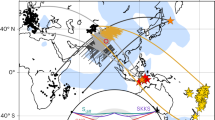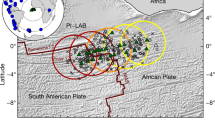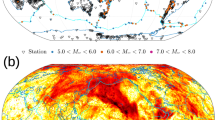Abstract
A ubiquitous feature of upper-mantle seismic velocity models has been the presence of high-velocity ‘keels’ beneath stable continental interiors1,2,3,4,5. Uncertainty remains, however, regarding the maximum depth to which continental keels extend, the degree to which they have cooled the mantle that surrounds them and their role in mantle flow. Here we investigate thermal anomalies across the eastern margin of the North American continental keel by imaging the seismic discontinuities at depths of 410 and 660 km with compressional-to-shear converted waves recorded by a 1,500-km-long seismometer deployment in the eastern United States. The thickness of the transition zone (the region nominally between depths of 410 and 660 km) and the depth to the ‘410-km’ discontinuity indicate that cold keel material and sub-keel downwellings must be largely confined to the upper mantle and may impinge on the transition zone only in localized regions and with thermal anomalies of less than ∼150 K. A 20-km depression of the ‘660-km’ discontinuity to the south of the westernmost stations coincides with a region of fast velocity in the deep transition zone2 and may be associated with the remnants of the subducted Farallon plate1,2,4.
This is a preview of subscription content, access via your institution
Access options
Subscribe to this journal
Receive 51 print issues and online access
$199.00 per year
only $3.90 per issue
Buy this article
- Purchase on Springer Link
- Instant access to full article PDF
Prices may be subject to local taxes which are calculated during checkout



Similar content being viewed by others
References
Grand, S. P. Mantle shear structure beneath the Americas and surrounding oceans. J. Geophys. Res. 99, 11591–11621 (1994).
Grand, S. P., van der Hilst, R. D. & Widiyantoro, S. Global seismic tomography: a snapshot of convection in the earth. GSA Today 7, 1–7 (1997).
van der Lee, S. & Nolet, G. The upper mantle S-velocity structure of North America. J. Geophys. Res. 102, 22815–22838 (1997).
van der Hilst, R. D., Widiyantoro, S. & Engdahl, E. R. Evidence for deep mantle circulation from global tomography. Nature 386, 578–584 (1997).
Jordan, T. H. Structure and formation of the continental tectosphere. J. Petrol.(Special Lithosphere issue) 11–37 (1988).
Flanagan, M. P. & Shearer, P. M. Global mapping of topography on transition zone velocity discontinuities by stacking SS precursors. J. Geophys. Res. 103, 2673–2692 (1998).
Gu, Y., Dziewonski, A. M. & Agee, C. B. Global de-correlation of the topography of transition zone discontinuities. Earth Planet. Sci. Lett. 157, 57–67 (1998).
Forte, A. M., Dziewonski, A. M. & O'Connell, R. J. Continent-ocean chemical heterogeneity in the mantle based on seismic tomography. Science 268, 386–388 (1995).
Doin, M.-P., Fleitout, L. & McKenzie, D. Geoid anomalies and the structure of continental and oceanic lithospheres. J. Geophys. Res. 101, 16119–16135 (1996).
Pari, G. & Peltier, W. R. The free-air gravity constraint on subcontinental mantle dynamics. J. Geophys. Res. 101, 28105–28132 (1996).
Peltier, W. R., Forte, A. M., Mitrovica, J. X. & Dziewonski, A. M. Earth's gravitational field: Seismic tomography resolves the enigma of the Laurentian anomaly. Geophys. Res. Lett. 19, 1555–1558 (1992).
Lenardic, A. & Kaula, W. M. Mantle dynamics and the heat flow into the Earth's continents. Nature 378, 709–711 (1995).
Bostock, M. G. Ps conversions from the upper mantle transition zone beneath the Canadian landmass. J. Geophys. Res. 101, 8393–8402 (1996).
Vinnik, L., Chevrot, S. & Montagner, J. P. Shear wave splitting in the mantle Ps phases. Geophys. Res. Lett. 24, 1007–1010 (1997).
Stammler, K.et al. The upper mantle discontinuities: correlated or anticorrelated? Geophys. Res. Lett. 19, 1563–1566 (1992).
Dueker, K. G. & Sheehan, A. F. Mantle discontinuity structure beneath the Colorado Rocky Mountains and High Plains. J. Geophys. Res. 103, 7153–7169 (1998).
Chen, Y. H., Roecker, S. W. & Kosarev, G. L. Elevation of the 410 km discontinuity beneath the central Tien Shan: evidence for a detached lithospheric root. Geophys. Res. Lett. 24, 1531–1534 (1997).
Revenaugh, J. & Jordan, T. H. Mantle layering from ScS reverberations, 2. The transition zone. J.Geophys. Res. 96, 19763–19780 (1991).
Gossler, J. & Kind, R. Seismic evidence for very deep roots of continents. Earth Planet. Sci. Lett. 138, 1–13 (1996).
Kennett, B. L. N. IASPEI 1991 Seismological Tables (Research School of Earth Sciences, Australian National University, Canberra, (1991)).
Mooney, W. D., Laske, G. & Masters, T. G. Crust 5.1: a global crust model at 5° × 5°. J. Geophys. Res. 103, 727–747 (1998).
Musacchio, G., Mooney, W. D., Luetgert, J. H. & Christensen, N. I. Composition of the crust in the Grenville and Appalachian provinces of North America inferred from Vp/Vs ratios. J. Geophys. Res. 102, 15225–15241 (1997).
Isaak, D. G. High-temperature elasticity of iron-bearing olivines. J. Geophys. Res. 97, 1871–1885 (1992).
Agnon, A. & Bukowinski, M. S. T. δs at high pressure and dlnVs/dlnVp in the lower mantle. Geophys. Res. Lett. 17, 1149–1152 (1990).
Fouch, M. J., Fischer, K. M. & Parmentier, E. M. Mantle flow contributions to shear wave splitting beneath continental roots. Eos 78(17), S322 (1997).
Karato, S.-I. & Wu, P. Rheology of the upper mantle: a synthesis. Science 260, 771–778 (1993).
Bina, C. R. & Helffrich, G. Phase transition Clapeyron slopes and transition zone seismic discontinuity topography. J. Geophys. Res. 99, 15853–15860 (1994).
Chopelas, A. Thermal properties of β-Mg2SiO4at mantle pressures derived from vibrational spectroscopy: implications for the mantle at 400 km depth. J. Geophys. Res. 96, 11817–11829 (1991).
Akaogi, M. & Ito, E. Refinement of enthalpy measurement of MgSiO3perovskite and negative pressure-temperature slopes for perovskite-forming reactions. Geophys. Res. Lett. 20, 1839–1842 (1993).
van der Lee, S. & Nolet, G. Seismic imaging of the subducted trailing fragments of the Farallon plate. Nature 386, 266–269 (1997).
Acknowledgements
We thank S. van der Lee and S. Grand for their mantle velocity models, Y. Shen for assistance with the receiver function analysis, G. Helffrich for a review, the IRIS/PASSCAL program for the seismometers used in the MOMA experiment, and M. Fouch, G. Al-Eqabi, P. Shore and the Lamont PASSCAL Instrument Center for their help with the deployment. Data for stations HRV and CCM were obtained from the IRIS Data Management Center. This work was supported by the Geophysics Program of the US NSF.
Author information
Authors and Affiliations
Corresponding author
Rights and permissions
About this article
Cite this article
Li, A., Fischer, K., Wysession, M. et al. Mantle discontinuities and temperature under the North American continental keel. Nature 395, 160–163 (1998). https://doi.org/10.1038/25972
Received:
Accepted:
Issue Date:
DOI: https://doi.org/10.1038/25972
This article is cited by
-
Seismic Wave Conversion Caused by Shear Crack Initiation and Growth
Rock Mechanics and Rock Engineering (2020)
-
Deformation in the lower crust and downward extent of the San Andreas Fault as revealed by teleseismic waveforms
Earth, Planets and Space (2014)
-
Lithospheric layering in the North American craton
Nature (2010)
-
Multiple seismic discontinuities near the base of the transition zone in the Earth's mantle
Nature (2000)
-
The elusive coldfinger
Nature (1998)
Comments
By submitting a comment you agree to abide by our Terms and Community Guidelines. If you find something abusive or that does not comply with our terms or guidelines please flag it as inappropriate.



